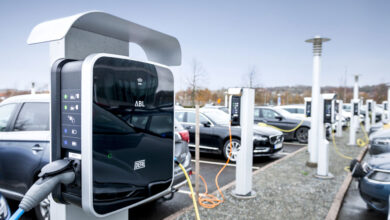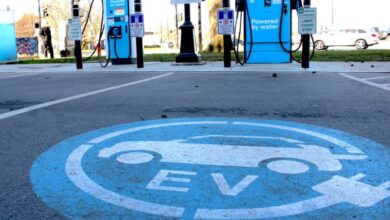Can hydrogen power overtake the electric vehicle surge

Volvo Trucks, the truck division of Swedish giant Volvo, plans to begin on-road tests with hydrogen-powered combustion engines in 2026, with a commercial launch slated for the decade’s end. This development raises a crucial question: Can hydrogen engines challenge electric vehicle dominance?
Trucks utilizing green hydrogen, rather than fossil fuels, offer a potential avenue for reducing carbon emissions in transportation. They may prove particularly advantageous for long-distance journeys and regions with limited charging infrastructure or time for battery recharging.
“Trucks, where the traditional internal combustion engine remains but runs on hydrogen, will have the same performance and reliability as our diesel trucks, but with the added benefit of potentially net zero CO2 emissions well-to-wheel. They will be a valuable complement to our battery electric trucks, which have been on the market for several years,” explained Jan Hjelmgren, Head of Product Management and Quality at Volvo Trucks.
The hydrogen-powered combustion engine trucks will enhance Volvo’s range of alternative options, including battery electric trucks, fuel cell electric trucks, and trucks running on renewable fuels such as biogas and HVO (Hydrogenated Vegetable Oil).
How green hydrogen fuels industries to net zero
Hydrogen provides a clean alternative for industries aiming for net-zero emissions. When made sustainably with renewable energy, known as green hydrogen, it becomes a versatile, low-emission energy source. It’s used across various sectors, such as materials, farming, construction, mining, and transportation.
Using a hydrogen-diesel dual fuel solution, known as a hydrogen power solution, ensures engine performance matches that of a standard diesel engine. This engine can run on a mix of hydrogen and diesel (or HVO and other renewable fuels), cutting CO2 emissions substantially. If hydrogen runs low, the engine seamlessly switches to pure diesel or HVO, ensuring uninterrupted operation and smooth performance.
Volvo Penta, Volvo’s marine branch, already uses sustainable fuel options like HVO100, a renewable diesel, which reduces greenhouse gas emissions by up to 90% compared to traditional diesel.
Despite its effectiveness, awareness about HVO100 remains limited. While attention is focused on new power solutions for the future, adopting this fuel is a quick way to significantly reduce CO2 emissions.
It is becoming clear that various similar technologies are also necessary to decarbonize heavy transport, including trucks.
“As a global truck manufacturer, we need to support our customers by offering a variety of decarbonization solutions, and customers can choose their alternative based on transport assignment, available infrastructure and green energy prices,” Hjelmgren said in a press release.
Electric trucks vs. combustion engines
While Volvo believes battery electric trucks are the main path to decarbonizing heavy transport, there will also be segments in which there is no alternative to the combustion engine.
“The hydrogen combustion engine technology shows its strengths when maximum weight has to be transported and there is no charging infrastructure for electric trucks nearby or no time for charging. It is also possible to use it in particularly hot regions where cooling a fuel cell would require too much energy,” Volvo Trucks told IE in a statement.
Furthermore, the company explains that “combustion engines that run on hydrogen will reduce CO2 with up to 95% (Tank-To-Wheel), when using fossil diesel as pilot fuel, and up to 100% when using HVO”.
Volvo trucks with hydrogen-powered combustion engines will incorporate High Pressure Direct Injection (HPDI) technology. This novel approach involves injecting a small amount of ignition fuel at high pressure to facilitate compression ignition before introducing hydrogen.
The benefits of HPDI include enhanced energy efficiency, which results in reduced fuel consumption and increased engine power.
“We work with a principle that we already apply to our LNG engines: we do not need spark plugs, instead we inject a small amount of pilot fuel, which can be fossil diesel or renewable HVO, that enables compression ignition in the combustion chamber. Immediately after ignition, the gas – in this case hydrogen – is fed into the combustion chamber by direct injection. The resulting combustion have a an efficiency and power comparable to a diesel engine (that is higher compared to low pressure spark ignited engines),” the company explains further.
Carbon-neutral transportation solutions
The company has been working on hydrogen combustion engine technology for several years and plans to start testing with selected customers in Europe in 2026.
Last week, Volvo Group and Westport Fuel Systems launched their joint venture dedicated to accelerating the commercialization and global adoption of Westport’s HPDI fuel system technology for long-haul and off-road applications.
Elsewhere, companies like Toyota focus on developing new internal combustion engines (ICEs). These engines aim to comply with stricter emissions regulations and can be used in various vehicles, including hybrids and those using biofuel.
The Japanese giant’s goal is to meet stringent emissions standards while moving away from fossil fuels to carbon-neutral alternatives like e-fuel, biofuels, and liquid hydrogen – promoting a wider use of carbon-neutral fuels.
In this initiative, a new 1.5-liter engine, 10 percent smaller and lighter than current models used in vehicles like the Yaris compact, is being developed alongside a new 2.0-liter turbo engine that will achieve similar reductions in size and weight compared to existing engines found in larger SUV models with three-row seating.
In another instance, the Southwest Research Institute (SwRI) successfully created a low-emission hydrogen-fueled demonstration vehicle as part of the SwRI’s Hydrogen Internal Combustion Engine (H2-ICE) consortium, which is supported by the industry.
The highlight of this demonstration is the development of a Hydrogen Internal Combustion Engine (H2-ICE) that significantly reduces nitric oxide (NOx) and carbon dioxide (CO2) emissions.
The H2-ICE has a 370-horsepower engine, producing 2,025 Newton-meters (nm) of torque for heavy-duty trucking. It’s efficient, emitting only about 1.5 grams of CO2 per horsepower hour (g/hp-hr). Based on previous projects, SwRI developed a tailored after-treatment system for hydrogen exhaust.
Furthermore, the H2-ICE vehicle demonstrates its potential as a zero-greenhouse gas option for the long-haul trucking industry, addressing the sector’s decarbonization needs.
ABOUT THE EDITOR
Bojan Stojkovski Bojan Stojkovski is a freelance journalist based in Skopje, North Macedonia, covering foreign policy and technology for more than a decade. His work has appeared in Foreign Policy, ZDNet, and Nature.



